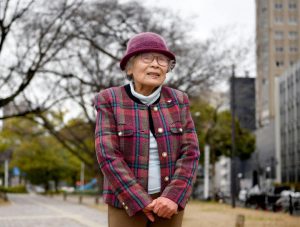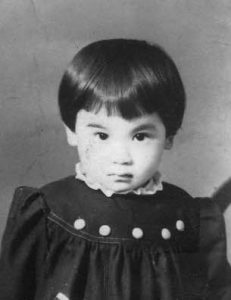Survivors’ Stories: Yasuko Kondo, 83, Nishi Ward, Hiroshima City — Walked across ruins of Hiroshima at age four
Feb. 13, 2024
She later resolved to speak of her experiences, including radiation’s acute effects
by Kyoko Niiyama, Staff Writer
For several days, starting the day after the atomic bombing, Yasuko Kondo (née Kinoshita), 83, was led by the hand of her mother, who carried her baby sister in the other arm, as the family walked around the ruins of downtown Hiroshima. Ms. Kondo shares her indelible experiences in the bombing as well as her battles with ill health afterward with students visiting Hiroshima on school trips.
At that time, in 1945, Ms. Kondo was living with her mother and her nine-month-old sister in the area of Tanaka-machi (now part of Hiroshima’s Naka Ward). The family was living apart from the father, who was fighting in a war zone to the south of Japan. Around April of that year, the family moved to a relative’s home in the area of Takasu (in the city’s present-day Nishi Ward) to avoid the air raids being conducted on the city.
On the day of the atomic bombing, the four-year-old Ms. Kondo was playing in a nearby stream. Suddenly, she sensed a flash of light and heard a loud boom. At her location about 3.5 kilometers from the hypocenter, she instinctively threw herself to the ground.
Soon, her mother rushed to her side, picked her up, and led the family to an air-raid shelter. Her younger sister, eyes rolling, appeared to be in serious pain. Inserting her hand into the baby’s mouth, her mother kept pulling out fragments of glass. Her sister’s lips and mother’s hand were stained with blood.
After a time, many victims fled from the city center. With burnt skin hanging from their bodies, the victims walked nearby with their arms extended in front of them. A man sitting beside a roadside Buddhist Jizo statue called out to her. “Child, please give me water,” the man implored. His voice was a moan that seemed to emanate from over his entire burned body. “I was so small, I couldn’t do anything for him,” said Mr. Kondo, describing her regret even now about her inaction.
On the morning of August 7, the mother and her two children headed back to their own home in Tanaka-machi. After arriving in Hiroshima’s downtown, their progress was hindered by rubble and collapsed bridges. At times, they were forced to forge ahead while stepping on dead bodies and the white bones of corpses with their wooden geta clogs. Reaching the area of their home around August 8 or 9, they found it had been burned to the ground without leaving a trace.
She and her family hopped on a small boat from Miyuki Bridge to travel to her grandparents’ home in Kure City, Hiroshima Prefecture. Soon, both she and her sister suffered from high fever and diarrhea. They experienced bloody stools and, at times, rectal protrusion of their intestines. Whenever her baby sister crawled across the floor, she left behind a trail of bloody stool. In that early period after the bombing, many people fell ill and died. “My mother was apparently preparing herself for our deaths,” explained Ms. Kondo. Nevertheless, around the end of 1945, both children recovered thanks to the family’s devoted care. Several years later, after his discharge from military service, the father built a shack on the site of their original home, allowing the family to return to that location.
Ms. Kondo married at the age of 29 and raised two children. Based on her experience of being bullied by others due to her A-bombing experience, she avoided the topic of the atomic bombing for many years. However, starting in 2001, after being persuaded by an A-bomb survivor acquaintance, she began to serve as a Hiroshima Peace Volunteer, guiding visitors around Peace Memorial Park. As A-bomb survivors continued to age, she became convinced of the need to share her own experience in the atomic bombing as a young child. And with that, since 2015, she has worked with the Hiroshima city government as someone who communicates to the public her experiences as an A-bomb survivor. In addition, nine people serving as what are called ‘A-bomb Legacy Successors’ are working to communicate Ms. Kondo’s experiences in the atomic bombing on her behalf.
In May of last year, when the summit meeting of the G7 (Group of Seven industrialized nations) took place in Hiroshima City, she recounted her experience in the atomic bombing to 45 journalists from six nations, including the world’s nuclear powers. Watching the journalists listen intently to her account, she strengthened her resolve “to convey the horror of the atomic bombing to people overseas.” To that end, she is now busy studying English. “People across the world must work hand-in-hand for the goal of eliminating nuclear weapons. I want to serve as a bridge for peace.”
(Originally published on February 13, 2024)









